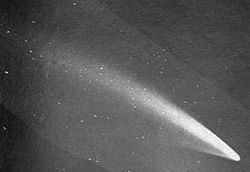- Great January comet of 1910
-
C/1910 A1 (Great January Comet,
Daylight Comet)
C/1910 A1, the Daylight or Great January Comet, photograph from Lowell ObservatoryDiscovery Discovered by: Multiple observers Discovery date: January 12, 1910 Alternate designations: 1910 I
1910aOrbital characteristics A Epoch: January 9, 1910 (JD 2418680.5) Aphelion distance: ~2974 AU[1] Perihelion distance: 0.128975 AU Semi-major axis: ~1487 AU[1] Eccentricity: 0.999995 Orbital period: ~57,300 yr[1] Inclination: 138.7812° Last perihelion: January 17, 1910 Next perihelion: unknown The Great January Comet of 1910, formally designated C/1910 A1 and often referred to as the Daylight Comet[2] appeared in January 1910. It was already visible to the naked eye when it was first noticed, and many people independently "discovered" the comet. At its brightest, it outshone the planet Venus, and was possibly the brightest comet of the 20th century.[3]
Contents
Discovery
The comet brightened rather suddenly, and was initially visible from the southern hemisphere only. A number of individuals claimed "discovery", but the comet is thought to have been first spotted by diamond miners in the Transvaal before dawn on January 12, 1910, by which time it was already a prominent naked-eye object of apparent magnitude -1.[3]
The first astronomer to properly study the comet was Robert T. A. Innes at the Transvaal Observatory in Johannesburg on January 17, after having been alerted two days earlier by the editor of a Johannesburg newspaper.
The comet reached perihelion on January 17 and was at that time visible in daylight with the unaided eye; following perihelion, it declined in brightness but became a spectacular sight from the northern hemisphere in the evening twilight, its noticeably curved tail reaching up to 50 degrees by early February.[3]
Halley's Comet and the Daylight Comet
The year 1910 saw considerable media interest in the predicted return of Halley's Comet, which reached perihelion on April 20. The appearance of the Daylight Comet several months earlier therefore came as something of a surprise, and made an extremely strong impression on an expectant public; when Halley's Comet returned again in 1986, many older people's accounts of having seen it in 1910 clearly referred to the Daylight Comet instead.[4]
Owing to a "telephonic error," the comet was initially reported as being named Drake's Comet, though once the error was realised the press afterwards referred to it as the Daylight Comet or Sunset Comet, as no single individual was credited with its discovery.[5]
See also
References
- ^ a b c Horizons output. "Barycentric Osculating Orbital Elements for Comet C/1910 A1 (Great January comet)". http://ssd.jpl.nasa.gov/horizons.cgi?find_body=1&body_group=sb&sstr=C/1910+A1. Retrieved 2011-02-07. (Solution using the Solar System Barycenter and barycentric coordinates. Select Ephemeris Type:Elements and Center:@0)
- ^ Moore, P. (2007), Space: The First 50 Years, New York: Sterling, p. 178, ISBN 1402752083.
- ^ a b c Bortle, J., "The Bright Comet Chronicles", harvard.edu, http://www.icq.eps.harvard.edu/bortle.html, retrieved 2008-11-18. Comet Ikeya-Seki was reported to reach a higher apparent magnitude close to perihelion by some observers.
- ^ Burnham, R. & Levy, D. (2000), Great Comets, New York: Cambridge University Press, p. 184, ISBN 0521646006.
- ^ "Not Much is Known of Daylight Comet. Greenwich Astronomer Thinks It Has Never Been Seen Before and May Never Be Again". New York Times. January 30, 1910. http://query.nytimes.com/gst/abstract.html?res=9400E7D61730E233A25753C3A9679C946196D6CF. Retrieved 2009-11-14. "Outside of politics the recently discovered daylight comet has been the chief topic of the week in England. It appears that the name of "Drake's comet," by which it has been generally known here, was given by mistake owing to a telephonic error, and it now goes by the name of the daylight or sunset comet."
External links
 Media related to Comet C/1910 A1 at Wikimedia Commons
Media related to Comet C/1910 A1 at Wikimedia Commons- JPL Orbit Simulator (Accessed 5/6/08)
- Donald Yeomans, "Great Comets in History". (Accessed 5/6/08)
- The Great Daylight Comet of 1910, by John W. Bortle, Sky and Telescope
Categories:- Comets
- 1910 in science
Wikimedia Foundation. 2010.
